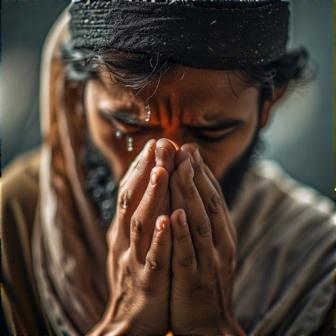In the heart of Islamic spirituality lies Istighfar, the act of seeking forgiveness from Allah. This simple yet profound practice cleanses the soul, brings peace, and draws believers closer to their Creator. The Holy Quran and the Sunnah of Prophet Muhammad (PBUH) emphasize its importance, promising immense rewards for those who repent sincerely. Whether you seek spiritual growth or wish to understand Islamic practices, these benefits will inspire you to make Istighfar a daily habit.
Understanding Istighfar: Seeking Forgiveness in Islam
What Is Istighfar?
Istighfar means asking Allah for forgiveness for sins, big or small, through words like “Astaghfirullah” (I seek forgiveness from Allah). It reflects humility and trust in Allah’s mercy. The Quran encourages repentance:
“And turn to Allah in repentance, all of you, O believers, that you might succeed.”
Surah An-Nur, Ayah 31
وَقُل لِّلۡمُؤۡمِنَـٰتِ یَغۡضُضۡنَ مِنۡ أَبۡصَـٰرِهِنَّ وَیَحۡفَظۡنَ فُرُوجَهُنَّ وَلَا یُبۡدِینَ زِینَتَهُنَّ إِلَّا مَا ظَهَرَ مِنۡهَاۖ وَلۡیَضۡرِبۡنَ بِخُمُرِهِنَّ عَلَىٰ جُیُوبِهِنَّۖ وَلَا یُبۡدِینَ زِینَتَهُنَّ إِلَّا لِبُعُولَتِهِنَّ أَوۡ ءَابَاۤىِٕهِنَّ أَوۡ ءَابَاۤءِ بُعُولَتِهِنَّ أَوۡ أَبۡنَاۤىِٕهِنَّ أَوۡ أَبۡنَاۤءِ بُعُولَتِهِنَّ أَوۡ إِخۡوَ ٰنِهِنَّ أَوۡ بَنِیۤ إِخۡوَ ٰنِهِنَّ أَوۡ بَنِیۤ أَخَوَ ٰتِهِنَّ أَوۡ نِسَاۤىِٕهِنَّ أَوۡ مَا مَلَكَتۡ أَیۡمَـٰنُهُنَّ أَوِ ٱلتَّـٰبِعِینَ غَیۡرِ أُو۟لِی ٱلۡإِرۡبَةِ مِنَ ٱلرِّجَالِ أَوِ ٱلطِّفۡلِ ٱلَّذِینَ لَمۡ یَظۡهَرُوا۟ عَلَىٰ عَوۡرَ ٰتِ ٱلنِّسَاۤءِۖ وَلَا یَضۡرِبۡنَ بِأَرۡجُلِهِنَّ لِیُعۡلَمَ مَا یُخۡفِینَ مِن زِینَتِهِنَّۚ وَتُوبُوۤا۟ إِلَى ٱللَّهِ جَمِیعًا أَیُّهَ ٱلۡمُؤۡمِنُونَ لَعَلَّكُمۡ تُفۡلِحُونَ
And tell the believing women to lower their gaze (from looking at forbidden things), and protect their private parts (from illegal sexual acts, etc.) and not to show off their adornment except only that which is apparent (like palms of hands or one eye or both eyes for necessity to see the way, or outer dress like veil, gloves, head-cover, apron, etc.), and to draw their veils all over Juyubihinna (i.e. their bodies, faces, necks and bosoms, etc.) and not to reveal their adornment except to their husbands, their fathers, their husband’s fathers, their sons, their husband’s sons, their brothers or their brother’s sons, or their sister’s sons, or their (Muslim) women (i.e. their sisters in Islam), or the (female) slaves whom their right hands possess, or old male servants who lack vigour, or small children who have no sense of the shame of sex. And let them not stamp their feet so as to reveal what they hide of their adornment. And all of you beg Allah to forgive you all, O believers, that you may be successful.
[24:31]
This verse highlights repentance as a path to success, making Istighfar a vital practice.
Why Istighfar Matters
The Prophet (PBUH) said, “Whoever constantly seeks forgiveness, Allah will appoint for him a way out of every distress and relief from every anxiety” (Sunan Abi Dawud, Hadith 1518). This Hadith shows Istighfar’s transformative power. Let’s explore its five benefits.
Benefit 1: Forgiveness of Sins
Cleansing the Soul
Istighfar erases sins, renewing one’s spiritual state. The Quran promises:
Surah Aal-E-Imran, Ayah 135
وَٱلَّذِینَ إِذَا فَعَلُوا۟ فَـٰحِشَةً أَوۡ ظَلَمُوۤا۟ أَنفُسَهُمۡ ذَكَرُوا۟ ٱللَّهَ فَٱسۡتَغۡفَرُوا۟ لِذُنُوبِهِمۡ وَمَن یَغۡفِرُ ٱلذُّنُوبَ إِلَّا ٱللَّهُ وَلَمۡ یُصِرُّوا۟ عَلَىٰ مَا فَعَلُوا۟ وَهُمۡ یَعۡلَمُونَ
And those who, when they have committed Fahishah (illegal sexual intercourse etc.) or wronged themselves with evil, remember Allah and ask forgiveness for their sins; – and none can forgive sins but Allah – And do not persist in what (wrong) they have done, while they know.
[3:135]
This verse assures that sincere repentance earns Allah’s forgiveness.
Practical Example
A student who lied about homework might say “Astaghfirullah” sincerely, feeling relieved as their heart is cleansed.
Prophetic Practice
The Prophet (PBUH), despite being sinless, said, “I seek Allah’s forgiveness seventy times a day” (Sahih Bukhari, Hadith 6307), setting an example for constant Istighfar.
Benefit 2: Relief from Stress and Anxiety
Finding Inner Peace
Istighfar alleviates worries by trusting Allah’s mercy. The Prophet (PBUH) said, “If anyone constantly seeks forgiveness, Allah will appoint for him a way out of every distress” (Sunan Abi Dawud, Hadith 1518).
Quranic Support
The Quran links Allah’s remembrance to tranquility:
Surah Ar-Ra’d, Ayah 28
ٱلَّذِینَ ءَامَنُوا۟ وَتَطۡمَىِٕنُّ قُلُوبُهُم بِذِكۡرِ ٱللَّهِۗ أَلَا بِذِكۡرِ ٱللَّهِ تَطۡمَىِٕنُّ ٱلۡقُلُوبُ
Those who believe (in the Oneness of Allah – Islamic Monotheism), and whose hearts find rest in the remembrance of Allah, Verily, in the remembrance of Allah do hearts find rest.
[13:28]
Istighfar, as a form of remembrance, brings calm.
Real-Life Example
A parent stressed about finances might recite Istighfar after Fajr prayer, finding peace and hope in Allah’s provision.
Benefit 3: Increased Blessings and Sustenance
Opening Doors of Provision
Istighfar invites Barakah (blessings) and sustenance. The Quran recounts Prophet Nuh’s (AS) advice:
Surah Nuh, Ayah 10-12
فَقُلۡتُ ٱسۡتَغۡفِرُوا۟ رَبَّكُمۡ إِنَّهُۥ كَانَ غَفَّارࣰا
“I said (to them): ‘Ask forgiveness from your Lord; Verily, He is Oft-Forgiving;
[71:10]
یُرۡسِلِ ٱلسَّمَاۤءَ عَلَیۡكُم مِّدۡرَارࣰا
‘He will send rain to you in abundance;
[71:11]
وَیُمۡدِدۡكُم بِأَمۡوَ ٰلࣲ وَبَنِینَ وَیَجۡعَل لَّكُمۡ جَنَّـٰتࣲ وَیَجۡعَل لَّكُمۡ أَنۡهَـٰرࣰا
‘And give you increase in wealth and children, and bestow on you gardens and bestow on you rivers.”
[71:12]
This verse links Istighfar to material and spiritual blessings.
Practical Example
A small business owner reciting Istighfar daily might notice increased customers, experiencing Allah’s promise of provision.
Historical Context
The Companions (RA), like Umar ibn Al-Khattab (RA), sought forgiveness during hardships, witnessing blessings in their community.
Benefit 4: Protection from Calamities
A Shield Against Harm
Istighfar safeguards believers from trials and punishment. The Quran warns:
Surah Al-Anfal, Ayah 33
وَمَا كَانَ ٱللَّهُ لِیُعَذِّبَهُمۡ وَأَنتَ فِیهِمۡۚ وَمَا كَانَ ٱللَّهُ مُعَذِّبَهُمۡ وَهُمۡ یَسۡتَغۡفِرُونَ
And Allah would not punish them while you (Muhammad SAW) are amongst them, nor will He punish them while they seek (Allah’s) Forgiveness.
[8:33]
This verse shows Istighfar as a protective shield.
Prophetic Teaching
The Prophet (PBUH) said, “Whoever says ‘Astaghfirullah’ three times after every prayer, Allah will protect him from the evil of his soul” (Sunan an-Nasa’i, Hadith 1404).
Example
A family reciting Istighfar during a storm might feel secure, trusting Allah’s protection, as communities did during the Prophet’s (PBUH) time.
Benefit 5: Closeness to Allah
Strengthening the Spiritual Bond
Istighfar draws believers nearer to Allah, fostering love and devotion. The Quran says:
“Indeed, Allah loves those who are constantly repentant and loves those who purify themselves.”
Surah Al-Baqarah, Ayah 222
وَیَسۡـَٔلُونَكَ عَنِ ٱلۡمَحِیضِۖ قُلۡ هُوَ أَذࣰى فَٱعۡتَزِلُوا۟ ٱلنِّسَاۤءَ فِی ٱلۡمَحِیضِ وَلَا تَقۡرَبُوهُنَّ حَتَّىٰ یَطۡهُرۡنَۖ فَإِذَا تَطَهَّرۡنَ فَأۡتُوهُنَّ مِنۡ حَیۡثُ أَمَرَكُمُ ٱللَّهُۚ إِنَّ ٱللَّهَ یُحِبُّ ٱلتَّوَّ ٰبِینَ وَیُحِبُّ ٱلۡمُتَطَهِّرِینَ
And they ask you about menstruation. Say, “It is harm, so keep away from wives during menstruation. And do not approach them until they are pure. And when they have purified themselves, then come to them from where Allah has ordained for you. Indeed, Allah loves those who are constantly repentant and loves those who purify themselves.”
[2:222]
This verse highlights Allah’s love for those who seek forgiveness.
Practical Example
A new Muslim reciting Istighfar before sleep feels a growing connection to Allah, enhancing their faith journey.
Prophetic Example
The Prophet (PBUH) taught Aisha (RA) to seek forgiveness often, showing its role in spiritual closeness (Sahih Muslim, Hadith 2702).
How to Practice Istighfar Daily
To maximize these benefits, incorporate Istighfar into your routine:
- After Salah: Say “Astaghfirullah” three times after every prayer (Sunan an-Nasa’i, Hadith 1404).
- Morning and Evening: Recite Istighfar with Dhikr, like “Astaghfirullah wa atubu ilayh” (I seek Allah’s forgiveness and turn to Him).
- During Hardship: Seek forgiveness to find relief, as advised in Sunan Abi Dawud, Hadith 1518.
- Before Sleep: Reflect on your day and ask for forgiveness to end it purely.
- Teach Others: Share Istighfar’s benefits with family, multiplying rewards.
Addressing Common Misconceptions
Misconception 1: Istighfar Is Only for Major Sins
Istighfar is for all sins, big or small, and even for shortcomings in worship. The Prophet’s (PBUH) frequent Istighfar, despite being sinless, proves this (Sahih Bukhari, Hadith 6307).
Misconception 2: Repentance Requires Perfection
Allah accepts sincere Istighfar, even if one stumbles again, as long as the intention is genuine (Surah An-Nur, Ayah 31).
Challenge: Consistency
Busy schedules may hinder regular Istighfar. Solution: Set reminders or recite it during daily tasks, like commuting, to stay consistent.
Challenge: Lack of Sincerity
Some may recite Istighfar mechanically. Solution: Reflect on sins and Allah’s mercy before reciting, ensuring heartfelt repentance.
Conclusion: Embracing Istighfar for a Blessed Life
Istighfar is a powerful act of worship that brings forgiveness, relieves stress, increases blessings, protects from harm, and fosters closeness to Allah. Rooted in the Quran and Hadith, its benefits touch every aspect of life, offering spiritual and worldly rewards. From the Prophet’s (PBUH) example to the Companions’ (RA) practice, Istighfar has been a cornerstone of faith. By making it a daily habit, Muslims can purify their hearts and strengthen their bond with Allah. Let this guide inspire you to embrace Istighfar in 2025, unlocking its transformative power for a life of peace and devotion.





